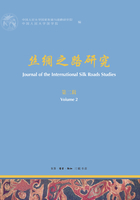
A Previously Unpublished Kharoṣṭhī Manuscript in Xinjiang Uygur Autonomous Region Museum
Jiang Yixiu (Peking University)
Abstract: This previously unpublished Kharoṣṭhī wooden tablet served as a letter reporting on some trade disputes. This article includes transcription, Chinese translation, and notes of this manuscript. The language of this unpublished manuscript could be seen as Sanskritized or hybridized Gāndhārī. Also, this manuscript offers new evidence about ancient Shan-Shan's kinship structure.
Keywords: Kharoṣṭhī manuscript, Niya, Gāndhārī language
[*] 本文为段晴教授主持国家社科基金重大项目“新疆维吾尔自治区丝路南道所遗存非汉语文书释读与研究”(项目编号: 12&ZD179)的阶段性研究成果之一,感谢段晴教授在文书释读过程中给笔者的帮助和指导。同样感谢新疆维吾尔自治区博物馆的工作人员,特别是李达老师提供的帮助。
[1]Mariner Padwa, An Archaic Fabric: Culture and Landscape in an Early Inner Asian Oasis (3rd-4th Century C.E. Niya), Ph. D. Dissertation, Harvard University, 2007, p.130.
[2]收件人为Kranaya与Lýipeya二人的文书出土于尼雅各处遗址,例如K19(N. i)、K88(N. iv)、K192(N. vi)、K243(N. xv)、K403(N. xvii)、KI502(N. xxiii)等等,在此不详述。KI为Kharoṣṭhī Inscriptions, discovered by Sir Aurel Stein in Xinjiang (A. M. Boyer, E. J. Rapson, E. Senart & P. S. Noble, 1929, Oxford: Clarendon Press)的缩写,下同。
[3]林梅村《犍陀罗语文书地理考》,《传统文化与现代化》1997年第6期,第33页。
[4]段晴、才洛太《青海藏医药文化博物馆藏佉卢文尺牍》,上海:中西书局,2016年,第38—41页。
[5]段晴、才洛太《青海藏医药文化博物馆藏佉卢文尺牍》,上海:中西书局,2016年,第54—55页。
[6]A. M. Boyer, E. J. Rapson, E. Senart & P. S. Noble, 1929, p. 323.
[7]林梅村《佉卢文时代鄯善王朝的世系研究》,《西域研究》1991年第1期,第45—50页。
[8]关迪《古鄯善国佉卢文简牍的形制、功用与辨伪》,《西域研究》2016年第3期,第90—91页。
[9]Otto Nikolaus Böhtlingk, Walter Rudolf Roth, Sanskrit-Wörterbuch. Vol. 4. Petersburg, 1865, p. 740.
[10]T. Burrow, A Translation of the Kharoṣṭhi Documents from Xinjiang, James G. Forlong Fund, Vol. XX, London: The Royal Asiatic Society, 1940, §133.
[11]刘文锁《沙海古卷释稿》,北京:中华书局,2007年,第286—289页。
[12]CBETA, T02, No.99, p. 293, a22.
[13][印]毗耶娑《摩诃婆罗多》(一),黄宝生等译,北京:中国社会科学出版社,2005年,第170页。
[14][印]毗耶娑《摩诃婆罗多》(三),黄宝生等译,北京:中国社会科学出版社,2005年,第118页。
[15]T. Burrow, 1937, §78.
[16]T. Burrow, 1937, §92。
[17]KI, p. 368; Mariner Padwa, “An Archaic Fabric: Culture and Landscape in an Early Inner Asian Oasis (3rd-4th Century C.E. Niya)”, p. 326.
[18]尼雅佉卢文文书使用犍陀罗语中的属格依主释见T. Burrow, §138。
[19]T. Burrow, §80.
[20]M. R. Jain, “Hindi Names”, Libri, 22(3), 1972, p. 225.
[21]T. Burrow, p.86.
[22]Richard Salomon, Two Gāndhārī Manuscripts of the Songs of Lake Anavatapta (Anavatapta-gāthā): British Library Kharoṣṭhī Fragment 1 and Senior Scroll 14. Gandhāran Buddhist Texts, Volume 5. Seattle: University of Washington Press, 2008, p. 427.
[23]段晴、张志清主编《中国国家图书馆藏西域文书——梵文、佉卢文卷》,上海:中西书局,2013年,第229页。
[24]Andrew Glass, A Preliminary Study of Kharoṣṭhī Manuscript Paleography, M.A. thesis, University of Washington, 2000.
[25]T. Burrow, §37.
[26]Andrew Glass, Four Gāndhārī Saṃyuktāgama Sūtras: Senior Kharoṣṭhī Fragment 5. Gandhāran Buddhist Texts, Volume 4. Seattle: University of Washington Press, 2007, p. 104.
[27]皮建军《精绝社会中的骆驼——基于尼雅出土佉卢文书》,北京大学硕士学位论文,2015年,第16页。
[28]Andrew Glass, Four Gāndhārī Saṃyuktāgama Sūtras: Senior Kharoṣṭhī Fragment 5. Gandhāran Buddhist Texts, Volume 4, p. 116.
[29]Richard Salomon, Two Gāndhārī Manuscripts of the Songs of Lake Anavatapta (Anavatapta-gāthā): British Library Kharoṣṭhī Fragment 1 and Senior Scroll 14. Gandhāran Buddhist Texts, Volume 5, p. 113.
[30]Timothy Lenz, Gandhāran Avadānas: British Library Kharoṣṭhī Fragments 1-3 and 21 and Supplementary Fragments A-C. Gandhāran Buddhist Texts, Volume 6, Seattle: University of Washington Press, 2010, p. 32.
[31]Richard Salomon, A Gāndhārī Version of the Rhinoceros Sūtra: British Library Kharoṣṭhī Fragment 5B. Gandhāran Buddhist Texts, Volume 1, Seattle: University of Washington Press, 2000, p. 92.
[32]段晴、才洛太《青海藏医药文化博物馆藏佉卢文尺牍》,第66页。
[33]Daniel Boucher, “Gāndhārī and the Early Chinese Buddhist Translations Reconsidered”, Journal of the American Oriental Society 118.4 (1998), p. 476.
[34]待刊。
[35]T. Burrow, §54.
[36]Franklin Edgerton. Buddhist hybrid Sanskrit grammar and dictionary. Vol. 1. Grammar. Yale University Press, 1953, §41.1.
[37]Mark Allon and Richard Salomon, “Kharoṣṭhī Fragments of a Gāndhārī Version of the Mahāparinirvāṇasūtra”, in Jens Braarvig, ed., Buddhist Manuscripts, Volume I. Manuscripts in the Schøyen Collection, I, Oslo: Hermes Academic Publishing, 2000, pp. 268-271.
[38]T. Burrow, “Tokharian Elements in the Kharoṣṭhī Documents from Xinjiang”, The Journal of the Royal Asiatic Society of Great Britain and Ireland, No. 4 (1935), pp. 673-675.
[39]F. W. Thomas, “Some Notes on the Kharoṣṭhī Documents from Xinjiang.”, Acta Orientalia 12 (1934), p. 63.
[40]翻译引自段晴、才洛太《青海藏医药文化博物馆藏佉卢文尺牍》,第43页。
[41]Mariner Padwa, “An Archaic Fabric: Culture and Landscape in an Early Inner Asian Oasis (3rd-4th Century C.E. Niya)”, pp. 204-211.
[42]段晴、才洛太《青海藏医药文化博物馆藏佉卢文尺牍》,第43页。